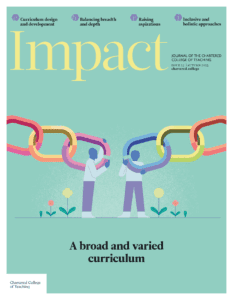Beyond the tick-box: Diversity in the curriculum

LOUISA DAVIES, THE CASTLE SCHOOL, SOUTH GLOUCESTERSHIRE, UK
Introduction
Despite our best intentions, too often our efforts to make our teaching more diverse can risk becoming tokenistic. We frequently lack the time to make substantial changes to our existing curriculum, we lack clarity from policy to guide us, we lack the finance to properly resource such changes or train staff, and we often lack public and media support for making necessary changes. These combined factors can lead to short-term solutions that feel safe but lack depth, leading to a makeshift approach that can curtail the extent of change we might want to and need to make.
When representation becomes separation
Students notice this. In a recent sixth form class, one student, tongue in cheek, asked, ‘Why should I care about Black History Month? Where’s my Asian History Month?’ Another commented that having a special focus on Black history defeated the object: ‘Doesn’t it just single Black history out as separate and not British?’
The student then argued that surely it could be both. This led to a discussion about awareness months and days and whether this was enough. The class concluded that it was important to shine a spotlight on voices that are frequently unheard, but it did leave us to wonder whether that also marked out those groups as ‘different’ or ‘other’, rather than being truly inclusive, whilst also further marginalising other minority groups.
Both visible and invisible
Rachel Macfarlane (2024) explores this paradox: in seeking to be diverse and inclusive, schools can make children – and staff – both hyper-visible and invisible. Macfarlane notes that this hyper-visibility ‘shines a spotlight on difference and disadvantage, leading to a heightened risk of marginalisation and stigmatisation’ (2024, p. 57). We might draw attention to students whom we know represent minority groups, kindly meant but making them all the more aware of their difference. We might also reveal their difference through our everyday choices of language – ‘mum and dad’ – or through the ‘write about your favourite Christmas gift’ task that we set, or through scheduling the headteacher’s reward lunch in the middle of Ramadan. When some questions from exam boards still carry narrow cultural assumptions, it’s all the more important that we use the choices that we do have in our own classrooms to offer something more inclusive. Yet our invisible children (and staff) are also at risk; many may actively seek to hide parts of themselves and their lives to fit in – they’ll fade into the background, which can lead to them being overlooked, isolated and lonely.
Representation matters
In response to the question ‘How diverse is education today?’ in Pearson’s 2020 survey of school staff, 32 per cent felt that the diversityThe recognition of individual differences in terms of race, ethnicity, gender, sexual orientation, socio-economic status, physical ability, religious beliefs and other differences of pupils and the world around them is not reflected. In the same survey, 80 per cent of teachers felt that more could be done to celebrate diverse cultures, people and experiences (Pearson, 2020, p. 5).
McKeating (2022, p. 342) notes that ‘Representation is important for all children to see themselves in learning tools, books and have role models in the home, school and around them… When we cannot see ourselves in the world around us this creates limited beliefs, a fixed mindset on what is achievable and increases othering.’ This is why we must continue to build on the good work already being done to ensure that there is a wider culture of belonging for all students.
But it’s not just about making students feel that they belong in their school community – a diverse curriculum allows students to ‘witness the full spectrum of human experience, where they see and read about people that look just like them, and develop empathy and understanding about those who don’t’ (Brett and Brassington, 2023, p. 52).
What can we do?
The following three key priorities arise from the recommendations in Pearson’s (2020) report:
1. Embed authentic representation
Awareness months, special assemblies and drop-down days are a good start when done sensitively. But representation must be embedded within everyday lessons – a concept that Sue Sanders calls ‘usualising’ – including voices and experiences so that they become an ordinary, expected part of the curriculum (Sanders, in Brett and Brassington, 2023, p. 52). Sometimes, this need not be a huge change. In my own classroom, simply including photos of sociologists alongside their work sparked discussion and challenged stereotypes.
In history, units on protest can feature not just the suffragettes or the Peasants’ Revolt but also Boudicca’s rebellion against Rome, and can be tied into more recent events, such as the #MeToo, Black Lives Matter and Pride movements. In food technology, students might learn about the cultural significance of dishes from a range of communities beyond their own lived experiences. They could also learn about different dietary needs, such as those related to medical conditions or personal choices, which offers a different aspect of diversity. Consider the images, names and scenarios being used in maths questions. Look at the diversity of authors and experiences in your English curriculum – indeed, in all subject reading lists – and ensure a range of material for students to pick up and read in school or subject libraries. Update your displays to showcase a diverse range of figures – and refer to them in your teaching.
Creating a truly inclusive curriculum is a large task and will require greater change beyond the immediate control of teachers. However, we should not wait for those wider structural changes. Carr notes that ‘People, not systems, change the way that people work’ (2023, p. 154). Staff should be empowered and encouraged to make changes in their own domains. The systems will follow.
2. Equip staff with skills and confidence
Teachers may feel uncomfortable or uncertain about exploring potentially sensitive or controversial issues. Schools need to commit to high-quality professional development that equips staff with the knowledge, confidence and skills to deliver a diverse curriculum. This can happen in-house if expertise is available, or through external speakers and community voices. When budgets are tight, providing staff with regular opportunities to reflect on representation within their subjects can still be highly effective. Encouraging staff to engage with existing research as part of their own personal development, in a more informal way, will also help build confidence.
3. Centre student voice – but thoughtfully
Students are often their own greatest advocates and will often tell you if they feel that your efforts are tokenistic or misguided. They need to be meaningfully included in conversations around inclusionAn approach where a school aims to ensure that all children are educated together, with support for those who require it to access the full curriculum and contribute to and participate in all aspects of school life. Student involvement can range from student surveys, working groups or school councils to more informal, ad hoc opportunities. It can take time for students to feel confident that their voices will actually be listened to. At the same time, we should not be reliant on students to speak on behalf of their identities. The important thing is to stay open to student participation and not to be defensive if our previous well-meaning efforts haven’t quite succeeded.
Conclusion
We would all like a bespoke, fit-for-purpose, fully funded and resourced new curriculum ready to go. But we all know that meaningful and lasting change will take time, effort and money. But it’s worth it. This isn’t just about curriculum; it’s about children, and our children deserve to feel seen, listened to and that they belong.
- Brett A and Brassington J (2023) Pride and Progress: Making schools LGBT+ Inclusive Spaces. London: Corwin UK.
- Carr V (2023) Leading with Love: How Compassionate Leadership Enables Schools to Thrive. London: David Fulton.
- Macfarlane R (2024) The A–Z of Diversity & Inclusion. Woodbridge: John Catt Educational.
- McKeating O (2022) Religion and mental health. In: Wilson H and Kara H (eds) Diverse Educators: A Manifesto. London: University of Buckingham Press, pp. 340–343.
- Pearson (2020) Diversity and inclusion in schools. Available at: https://web.archive.org/web/20230215080000/https://www.pearson.com/en-gb/schools/insights-and-events/topics/diversity-inclusion/schools-report.html (accessed 20 April 2025).










